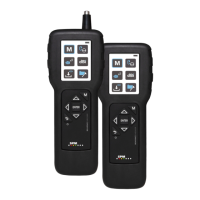25
NOTE! A reading taken with an incorrect dBi value causes an incorrect evaluation of the bearing condi-
tion! Always check that the correct dBi for the bearing in question has been entered!
Evaluation simply means that you make sure that the information you pass on to the maintenance person-
nel is as correct as possible and as detailed as necessary. Always remember that
• some machines can contain many types of shock pulse sources other than the bearing, and
• there can be a number of different causes for bad bearing condition other than damage.
Evaluation requires only normal care and common sense. Use the probe transducer and the headphone,
and also use your senses: look, touch, listen. By being thorough you can avoid raising false alarms or miss-
ing damaged bearings.
Initial readings and changes
There are only two situations where an evaluation is necessary. The first is when you start with bearing
monitoring:
• Always evaluate the first readings on new measuring points and newly installed bearings.
The purpose is to establish a reliable base for routine measurements. You want to be quite sure that you
are measuring shock pulses from the bearing and that the reading itself is correct. If you find that bearing
condition is good, you do not have to evaluate the following readings on that measuring point as long as
there is no significant change.
The other situation is when you notice a change in the readings (or get high readings from the start):
• Investigate any significant increase or decrease of the shock pulse level.
Again, you want to be quite sure that you are measuring shock pulses from the bearing and that the read-
ing itself is correct.
If you find that bearing condition is not good, you have to distinguish between bad installation, poor lubrica-
tion, overload and damage, in order to decide what kind of maintenance work is needed. If you are getting
an interference signal, it is probably caused by machine faults which have to be reported and repaired.
Machine Bearing Bearing Bearing
alignment lubrication installation damage
High maximum value
Interference
Cross talk from
other bearings
Interference from
mechanical shocks
Operating condition not good
Evaluating Bearing Condition
1 Reading correct ? Check!
Measuring point? Installation ? Correct dBi ? dBm?
Look, feel, check data.
2 Shock pulse source? Search!
Bearing ? Interference? Signal pattern? Loose
parts?
Look, listen. Use probe transducer, headphone.
3 Bearing fault? Analyze!
Lubrication? Alignment? Installation?
Bearing damage?
Identify shock pulse pattern.
Check trend. Test lubrication.

